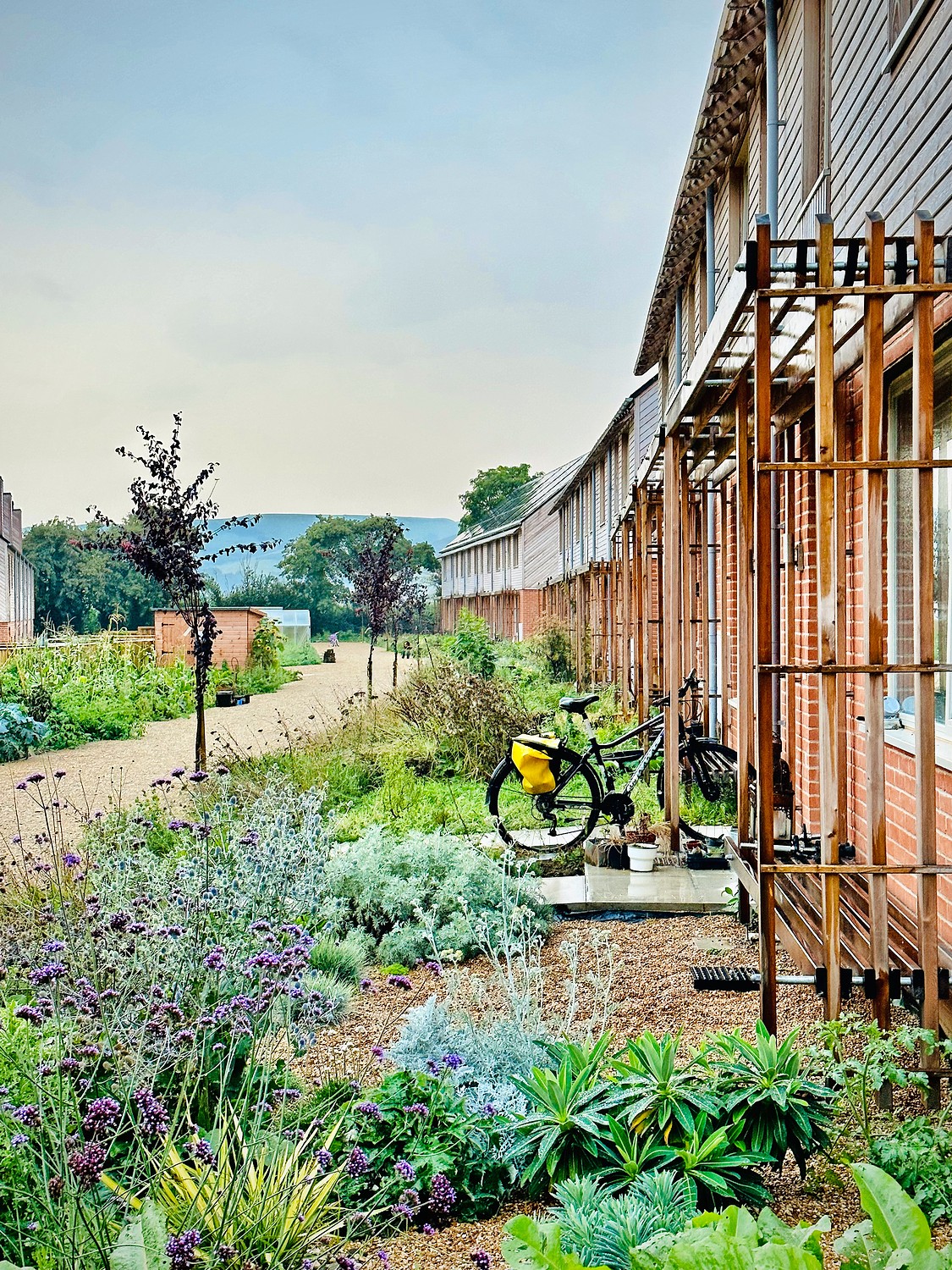Hazelmead
Bridport, Dorset
“The children have gravitated to the swings under the big oak tree,” says Judith Griffies. “There’s a sacred circle bit and a fire pit where we toast marshmallows and have a glass of wine.” Behind her a new orchard is starting to grow; beyond that a shaggy row of mature trees preserved as a “wilderness edge”. Around her are rows of handsome houses in reddish brick and silvery Siberian larch, whose unfenced front gardens merge with a shared landscape of grass and weeds and more kempt beds of flowers and vegetables. People are pushing wheelbarrows about in the spring sunshine, children are weaving their way home from school, preparations are in hand for a session of “tea and cakes and dealing with dock leaves”.
The houses are well proportioned and well lit by large windows, in terraces that follow the contours of the sloping land, framing views of surrounding hills. Cars are at the site’s edge, so spaces between houses are used for sociability and children’s play. Rainwater drains through swales – shallow, earth-filled channels in which wildflowers grow. Solar panels on roofs, linked to a huge on-site battery, provide power. This is a place of simple qualities, some of which used to be taken for granted, some updated for modern concerns about climate.
This idyll is Hazelmead, a development of 53 homes ranging in size from one to four bedrooms on the edge of Bridport, the Dorset town known for its literary festival, cider and a famous hat shop. The project is billed as Britain’s largest example of cohousing, which is a way of building communities in which residents are involved in everything from the design and commissioning of new homes to managing them once built, to hands-on help with gardening, construction and maintenance. Cohousing projects combine private homes with communal facilities, such as kitchens and dining rooms for collective meals, and laundries. At Hazelmead, residents are currently building a “common house” for meetings and events, and for such things as yoga, music and dance, applying clay render to its straw bale walls (on a timber frame) with their own hands.

Here, in contrast with other cohousing developments, all the housing is affordable, within a definition stretching from homes at social rent to others at 80% of market value. It’s the creation of a dedicated group of people who, in response to a local housing market where homes cost about 15 times average income, set about establishing a place that would be more affordable, sustainable and neighbourly. It hasn’t been easy. It has taken over 16 years from conception to completion and required its pioneers to risk time and money with no initial guarantee of success.
It started with an idea by Alan Heeks, a local resident and businessman turned eco-enthusiast who co-founded a cohousing community near the north Dorset town of Gillingham; he thought that it would be good to create such a place in Bridport. A meeting was held of interested parties, a steering group set up, a site identified and the Bristol-based Barefoot Architects appointed, a newly formed firm led by Sam Goss and Rob Hankey. Common Practice, a firm of young local architects, was later chosen to design Hazelmead’s common house. An expert in construction, Charles Couzens, provided guidance. The then local MP, Oliver Letwin, gave support and advice. A community benefit society was set up.
It all took resources, energy and time, to say nothing of persuading a reluctant local council to grant planning permission, raise funding – sometimes from friends, family and supporters, sometimes from public bodies such as Homes England and Dorset Council – and set up a partnership with the Bournemouth Churches Housing Association to help deliver the new homes. There was an intricate negotiation with the NHS, as access to Hazelmead crosses the land of a hospital, which led to the designation of six homes for nurses.
In all of this, Bridport Cohousing stayed true to its ideals. It’s run as a “sociocracy”, which Griffies says is “consent, not consensus – everybody having a voice but not everyone making decisions” on every subject. People grouped in “circles” and “subcircles” deal with such things as permaculture, finance, the environment and communications. If this all sounds a bit dreamy and diffuse for the delivery of a complex £9.5m project, here it is nonetheless. All residents have to be members of the society and commit to its principles, which means, as a minimum, going to regular meetings.

The reward for all this endeavour is, at its simplest, good quality homes at affordable prices. “People were moving from horrible, damp houses,” says Griffies, whose only source of heat in her last home was firewood she had to chop herself. There is also a powerful and palpable community spirit. Residents talk of the “generosity” of the place, of the level of care, of people looking out for each other and helping each other out. Talent Ropafadzo Mudondo, a nurse from Zimbabwe, compares it to the spirit of togetherness in her homeland, which she has until now struggled to find in Britain. “Most of the people in this country are so lonely,” says her daughter Natalie. For Lin Scrannage, who is 71, living in Hazelmead is transformative. “Being the age I am,” she says, “I’m looking forward to having a future.”
This spirit is created by visible and invisible structures. Relationships are encouraged by the layout of the buildings, with such things as benches in front of every house, and by the organisation of the society. As it turns out, Hazelmead lacks (for budget reasons) the shared laundry and guest rooms that are characteristic of cohousing projects elsewhere, and the common house is still inching towards completion. Yet the development’s ambitions for neighbourliness seem to be succeeding well without them.
The architect Sam Goss, for whom Hazelmead is a career-launching project, is messianic about cohousing. “Why doesn’t every town, city, village have one?” he asks. Possibly because they tend to take so long and are hard to achieve, one might guess, but this project makes a convincing argument for the benefits of all that effort. Even if setting up an organisation and attending meetings is not for everyone, basic good things like shared car-free spaces and benches outside the houses should be in every kind of housing development.
Photographs by Rebecca Noakes
This article was amended on 7 May 2025. An earlier version stated incorrectly that Bridport was in Devon not Dorset.

